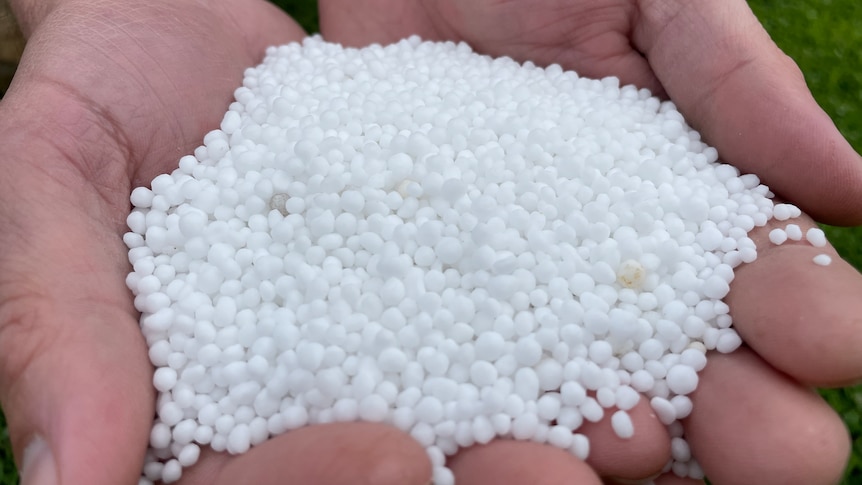With several governments around the world pursuing limits on nitrogen fertilizer use in agriculture, how would farmers adapt if the Australian government took a similar approach?
Key points:
- Fertilizer production and use is responsible for more than half of the greenhouse gas footprint of the national wheat crop
- Nitrous oxide emissions come from the volatilisation of nitrogen fertilizers like urea
- Volatilization can be minimized through management, but synthetic nitrogen is hard to replace in cropping systems
Birchip Cropping Group senior research manager James Murray said the obvious way to reduce emissions from nitrogen fertilizer was to use less of it.
“I naturally guess the go-to option is to grow more legumes in the rotation, because when we grow legumes we don’t need to apply nitrogen to meet production,” he said.
“But it’s not as simple as that, because there are greenhouse gas emissions such as nitrous oxide associated with the breakdown of legume stubbles.”
In broadacre cropping, fertilizer production and use accounted for 58 per cent of the Australian wheat crop’s greenhouse gas footprint in the past five years, according to the Department of Agriculture.
Of that, 31 per cent occurred on-farm, a large part of which came through the volatilization of nitrogen fertilizer, where nitrous oxide is released into the atmosphere.
Nitrous oxide is a greenhouse gas that is almost 300 times more potent than carbon dioxide.
Apart from growing more nitrogen-fixing legumes to reduce fertilizer use, Mr Murray says there are products available to slow the volatilisation process, which occurs when nitrogen is applied to a crop and there is insufficient rainfall following application to break it down.
“There are a couple of products on the market — one is a urease inhibitor, which reduces that volatilization risk by slowing that release when you apply if you don’t get follow-up rainfall relatively quickly,” he said.
“The other one is a polymer coating, which slows the release of nitrogen quite significantly.
“But the challenge with them is they’re not necessarily cost-effective to utilize, with the urease inhibitor retailing for about $50 a tonne on top of your urea cost, so it opens up a question about how cost effective that is in farming system.”
Mr Murray said whether or not farmers used a urease inhibitor, there was significant value in getting nitrogen application right and minimizing volatilisation.
“We talk a bit about the four Rs — so the right rate, the right product, the right source and the right timing, which at the end of the day will have significant benefits for production, and if we’re reducing our greenhouse gas footprint at the same time, that’s a bonus,” he said.
Countries including New Zealand, Canada and the Netherlands are enforcing limits on fertilizer application to reduce emissions, which Mr Murray says is a consideration for farmers here.
“There are considerations around market access and potential future mandates on how things are utilized,” he said.
“I think there’s a great opportunity for the Australian grains industry to be ahead of the game on this stuff, whether it’s for market access or potential mandate considerations.
“In terms of improving the way we use our inputs, the biggest benefit is to the bottom line in terms of improving crop production.”
What are the alternatives?
Some farmers are trialling alternatives to synthetic fertilizer under the broad umbrella of “regenerative agriculture”.
Among them is Luke Batters, who farms with his family near St Arnaud in western Victoria.
“Our operation is largely a synthetic-based system and our use of synthetic fertilizers and chemicals has increased substantially,” he said.
“I was working out of agriculture for seven years and when I came back to the farm I had a different mindset and so we’re trialling a few different things around inputs, in terms of how different carbon and biological and chemistry-based inputs affect the system.”
Mr Batters is trialling alternatives like compost, manure, seaweed and vermicast, which is a mixture of products, including worm castings.
“It wasn’t until I started doing this trial work that I realized how reliant we were on nitrogen as a synthetic input,” he said.
What are the problems?
Mr Batters said while he thought his trials were otherwise healthy, they were severely lacking in nitrogen and he had not been able to make up the shortfall with the alternatives he has used.
“I went largely cold turkey and stopped using synthetic fertilizers and it’s been quite stark, the difference between applied synthetic fertilizers and no synthetic fertilizer and having to rely on those alternatives,” he said.
“These things will work in a system once the biology gets up and going, but because our current system is so depleted of biology, it really hasn’t taken off.”
Mr Batters said he had not achieved the results he was hoping for but he would persist.
“If there are regulations in the future around what we can and can’t do and we haven’t got an alternative we’ll come unstuck,” he said.
.
